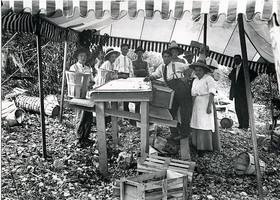
The earliest development of a commercial fruit industry in West Virginia occurred in the Northern Panhandle and down the Ohio Valley. Legend has it that Johnny Appleseed (John Chapman, 1774–1845) and his brother floated down the Ohio River to what is now Wellsburg, where they planted several apple nurseries. Whatever their origin, apple trees from regional nurseries were distributed throughout the area. Apple production increased until there was a surplus beyond local needs, and the first commercial shipments down the Ohio occurred in the early 1800s. The Northern Panhandle apple industry appears to have prospered until the Civil War, when shipments came to a halt. This resulted in a marked decrease in local commercial production, but during this time and into the late 1800s apple trees and small orchards appeared on farms throughout the state.
Although it was largely responsible for the failure of commercial fruit growing in the Northern Panhandle, the Civil War resulted in the beginning of the industry in the Eastern Panhandle. William S. Miller (considered by many to be the father of modern commercial orchard development in West Virginia) planted his first orchard of 16 acres near Gerrardstown, Berkeley County, in 1851. At the start of the Civil War, Miller had a large supply of orchard stock and no market. He solved this problem by expanding his own orchard and at the close of the war had nearly 4,000 peach trees and several hundred apple trees coming into production.
Fruit production rapidly expanded throughout the Eastern Panhandle counties of Jefferson, Berkeley, Hampshire, Morgan, and Mineral. By 1889, West Virginia apple production had reached about 4.5 million bushels. Production fluctuated from a low of less than two million bushels in 1921 to a peak of more than 12 million bushels in 1931. Annual production at the end of the 20th century averaged more than 3.5 million bushels. Peach production has varied from a low of approximately 200,000 bushels in 1934 to a high of more than 900,000 bushels in 1954. Average peach production was 279,000 bushels during the decade of the 1990s. West Virginia ranks ninth or tenth in apple production and 13th or 14th in peach production in the U.S., with a combined annual crop value averaging more than $17 million the past 10 years. There are currently about 7,000 bearing acres of apples and 1,200 bearing acres of peaches in the state. All but six to eight of the commercial orchards in the state are located in the Eastern Panhandle.
Where 40-foot-tall ‘‘standard’’ apple trees once were the norm, most commercial producers now grow semi-dwarf or dwarf apple trees. High-density planting requires fewer acres of land with many more trees per acre, perhaps 300 dwarf trees rather than 50 standard trees. Sometimes the small trees are supported on wire trellises, like grapevines in a vineyard. Thus, while the acres of land in orchard production have decreased, the total apple harvest has remained relatively constant.
In the past, most farms had a small orchard to provide for the family’s needs, while today’s commercial orchard producers are specialized, growing only tree fruit. There is one growing exception: More tree fruit producers are beginning to explore the addition of small fruits to their operations, including strawberries, red raspberries, blackberries, black raspberries, and blueberries.
There was a great change in the fruit industry with the decline of large-scale hard cider production as a result of the Temperance movement and other causes. Cider apples, chosen for tartness and juicing qualities and with little attention to appearance, fell out of favor. Modern dessert apples, chosen for their taste when eaten fresh, came to predominate.
The most common apples grown commercially in West Virginia today include Red Delicious, Golden Delicious, York Imperial, Rome Beauty, Stayman, and Gala. Other varieties grown here include Granny Smith, Braeburn, Fuji, Jona Gold, Pink Lady, Ginger Gold, and Cameo. There is an increasing interest in old apple varieties, and some growers are growing so-called ‘‘heritage’’ apples, including Wolf River, Black Limbertwig, Walker’s Pippin, Virginia Beauty, and Baldwin. West Virginia is the native home of two commercial apple varieties, the Grimes Golden and the Golden Delicious.
In 1930, the West Virginia University Experiment Farm was established at Kearneysville, Jefferson County. Now known as the WVU Kearneysville Tree Fruit Research and Education Center, its faculty and staff continue the tradition of research and educational programs in support of the tree fruit industry.
This Article was written by Richard Zimmerman and Henry Hogmire
Last Revised on November 28, 2018
Related Articles
Cite This Article
Zimmerman, Richard and Henry Hogmire "Orchards." e-WV: The West Virginia Encyclopedia. 28 November 2018. Web. 26 July 2024.


Comments?
There aren't any comments for this article yet.
Click here to read and contribute to the discussion →